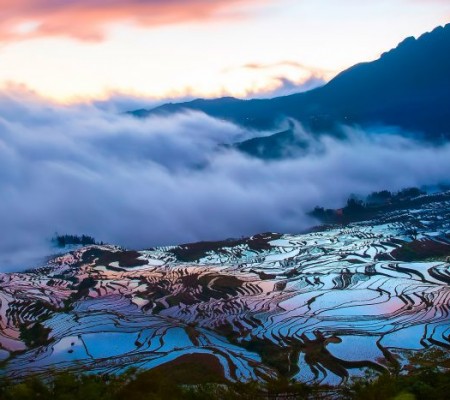
History of Xishuangbanna Dai Autonomous Prefecture
Ancient Period (Pre-109 BCE)
- Inhabited by Dai (傣族) and other ethnic groups
- Part of the ancient “Dianxiang” (滇象) tribal region
- Developed early agricultural civilization with rice cultivation
Imperial Era (109 BCE – 1911)
- 109 BCE: Incorporated into the Han Dynasty’s Yizhou Commandery (益州郡)
- 8th-12th century: Became the center of the “Mengbalaxi” (勐巴拉娜西) Dai kingdom
- 1180: Established as the “Jinglong Golden Hall Kingdom” (景龙金殿国)
- 13th-19th century: Ruled by the Cheli Xuanweishi (车里宣慰使) under imperial China’s tusi (土司) system
Modern Period (1912-1949)
- 1913: Reorganized as Pu’er Circuit (普洱道)
- 1927: Became part of Yunnan Province’s administrative system
- WWII: Strategic location along the Burma Road (滇缅公路)
Contemporary Era (1950-Present)
- January 23, 1953: Established as Xishuangbanna Dai Autonomous Prefecture
- 1980s: Began developing as a major tourist destination
- 1990s: Designated as a key border economic cooperation zone
- 2000s: Became China’s leading rubber and tea production base
- 2010s: Developed as a hub for ecological tourism and BRI connections to Southeast Asia
Key Historical Notes:
- The name “Xishuangbanna” comes from the Dai language “Sipsongpanna” (十二千田), meaning “twelve rice-growing districts”
- Maintained the most complete Dai cultural traditions in China
- Served as a bridge for Buddhist cultural exchange between China and Southeast Asia
- Unique matrilineal social structures preserved among some ethnic groups
The prefecture’s history reflects its dual role as:
- A frontier zone between Chinese civilization and Southeast Asia
- A cultural preserve for diverse ethnic traditions
- An ecological treasure trove (China’s only tropical rainforest)

 7 Days GolfingTour
7 Days GolfingTour
 8 Days Group Tour
8 Days Group Tour
 8 Days Yunnan Tour
8 Days Yunnan Tour
 7 Days Shangri La Hiking
7 Days Shangri La Hiking
 11 Days Yunnan Tour
11 Days Yunnan Tour
 6 Days Yuanyang Terraces
6 Days Yuanyang Terraces
 11 Days Yunnan Tour
11 Days Yunnan Tour
 8 Days South Yunnan
8 Days South Yunnan
 7 Days Tea Tour
7 Days Tea Tour
 8 Days Muslim Tour
8 Days Muslim Tour
 12 Days Self-Driving
12 Days Self-Driving
 4 Days Haba Climbing
4 Days Haba Climbing
 Tiger Leaping Gorge
Tiger Leaping Gorge
 Stone Forest
Stone Forest
 Yunnan-Tibet
Yunnan-Tibet
 Hani Rice Terraces
Hani Rice Terraces
 Kunming
Kunming
 Lijiang
Lijiang
 Shangri-la
Shangri-la
 Dali
Dali
 XishuangBanna
XishuangBanna
 Honghe
Honghe
 Kunming
Kunming
 Lijiang
Lijiang
 Shangri-la
Shangri-la
 Yuanyang Rice Terraces
Yuanyang Rice Terraces
 Nujiang
Nujiang
 XishuangBanna
XishuangBanna
 Spring City Golf
Spring City Golf
 Snow Mountain Golf
Snow Mountain Golf
 Stone Mountain Golf
Stone Mountain Golf




